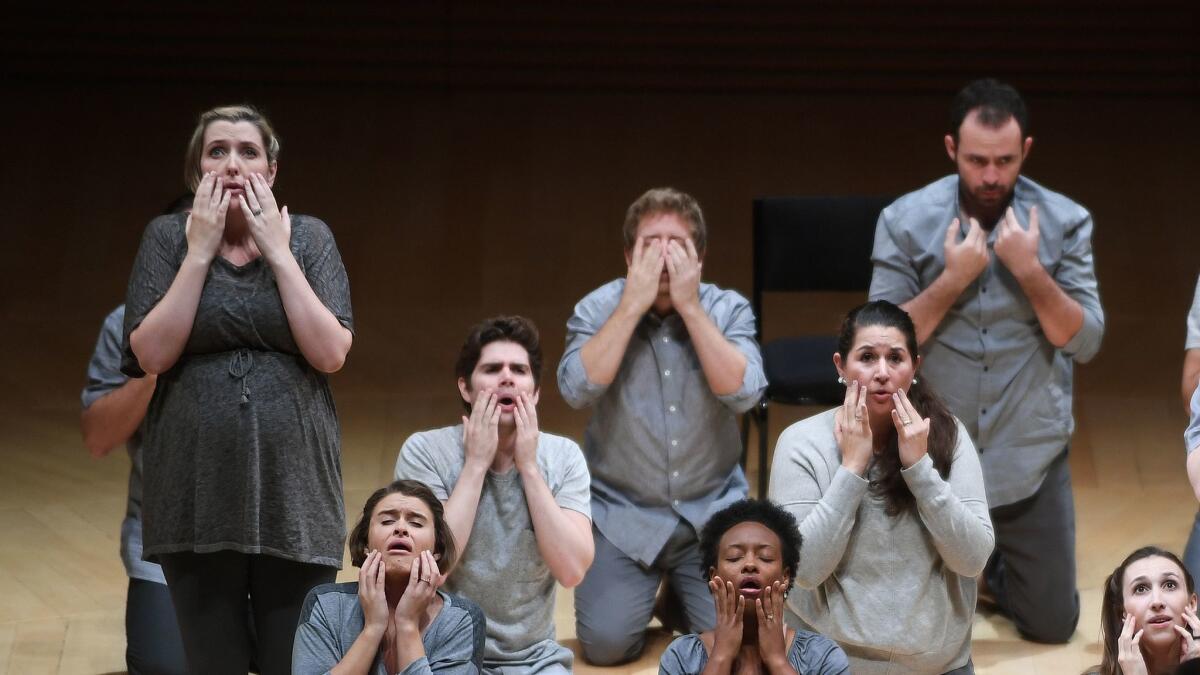Review: Why music from 1594 still moves us in 2016: The deep meaning of ‘Tears of St. Peter’

- Share via
Music historians have never quite known what to make of the late Renaissance composer Orlando di Lasso, or, for that matter, even what to call him. (Sometimes he’s Orlande or Roland, and sometimes De Lassus.) Musicologist Richard Taruskin calls him, simply, a loose end. Di Lasso’s style never fully conformed to the luxurious perfection of his age. His bizarre harmonic explorations, along with his attraction to lurid or mystical subject matter, could get him into trouble.
He wrote some 300 Masses, more than 2,000 compositions over all, but we don’t know how many exactly. (There has never been a compete published edition of his works.) One thing, though, has long been fairly certain: It is best to steer clear of Di Lasso’s last piece, “Lagrime di San Pietro” (Tears of St. Peter).
But when someone says, “don’t,” that has more than once told artistic director Grant Gershon what the Los Angeles Master Chorale should do. On Saturday night at Walt Disney Concert Hall, he opened a new season with 21 singers from the chorus premiering a revelatory staging by Peter Sellars of Di Lasso’s 21-madrigal cycle.
Normally, we turn to death-invoking music for its transformative powers. The final great works of Beethoven (the late string quartets), Mozart (the unfinished Requiem) or Mahler (the Ninth Symphony’s probe of dying embers) help us transcend despair. Di Lasso’s “Lagrime,” however, is by a deeply depressed composer in the days before meds, someone who only wants his misery to end. It did in 1594, three weeks after finishing the score.
Each madrigal mercilessly finds a new metaphor for punishing Peter, having denied Jesus. The spiritual anguish expressed in Peter’s remorse and Jesus’ disappointment — a gaze from divine eyes can be so severe that light waves turn into sound able to penetrate ears — piles up until the pain reaches a breaking point.
Because Di Lasso’s music is full of sublime beauty, the most convenient way to deal with the unrelenting despair of “Lagrime,” on the rare occasions it is performed or discussed (it is, for instance, treated as a mere aside in the Cambridge University Press volume of “Orlando di Lasso Studies”), is to bask in glowing religiosity. But the revelation offered by Sellars and Gershon is to avoid Revelation altogether. For them, “Lagrime” is a profoundly human contemplation of the relationship of these two men.
Dressed in peaceful mauves and grays (designed by Danielle Domingue Sumi) and warm light (by James F. Ingalls), the chorus congregates onstage, a warm-hearted community evoking “warm-hearted Peter,” who had sworn to defend Jesus amid a thousand spears and swords but was overcome by cowardice at the last minute. Now, Peter’s heart has been wounded by a thousand blows of self-remorse.
Each madrigal, set to rhymed Italian stanzas by Renaissance poet Luigi Tansillo, is a small contrapuntal masterpiece consisting of seven individual melodic lines that flow as currents, never standing alone, but ever completing and renewing thoughts. The overlaps create unpredictable harmonies that can make your hair stand on end.
Each madrigal, moreover, begins with a serene, straightforward melody but gradually becomes contrapuntally intricate and agitated and multidimensional. The singers, said to be the first to have undertaken the herculean task of memorizing more than an hour’s worth of this music that never repeats and never goes where you might expect, appear to absorb the drama, enacting the text as Sellars translates it on the titles projected above the stage. Those translations use common, modern language, not the more common biblical construction.
Some of the lines between Peter and Jesus are exchanges of increasingly disturbing incriminations, as well as descriptions of the tolls they take on both parties. With the singers humanizing every gesture, at times, Peter and Jesus seem capable of the psychic cruelty only old lovers can inflict. Next to them, Edward Albee’s characters are children in a playground.
The 15th madrigal begins by Peter asking life to leave him. He can take no more. Nothing more can be accomplished. The chorus ends it by lying on the floor, in a position of crucifixion. For the following madrigals, the chorus gives up, as well. The singers move to either side of the stage and sit on chairs faced with music stands. Peter is no longer connected to this world. “Afraid to die,” Peter finally grasps, “I denied life.”
For the last madrigal, the dying Di Lasso turned to a 13th century Latin text in which Jesus accuses Peter of inflicting a graver internal agony than even the indescribable pain of crucifixion. For Di Lasso, Peter’s otherworldly solace may be found in a new harmonic language.
Jesus has the last scathing word: “I have experienced such ingratitude from you.” But Sellars allows us to hear it as being spoken in love, not anger. Members of the chorus, up from their chairs, hug one another. Gershon is among them. Di Lasso’s wandering harmonies have somehow wandered into our own. Sorrow and bitterness are replaced by awe.
“Lagrime” is a major accomplishment for the Master Chorale, which sang and acted brilliantly. It is also a major accomplishment for music history. The company hopes to keep this production alive, touring it, and if the music business chooses to honor the just, that will be a saint’s compensation.
ALSO
Dudamel brings his YOLA youth symphony’s spirit, and message, to Oakland
Chicago-based Dal Niente pops up in new L.A. music series called Poolhouse
WikiLeaks at the Opera: What Chelsea Manning-inspired music says about government secrets
More to Read
The biggest entertainment stories
Get our big stories about Hollywood, film, television, music, arts, culture and more right in your inbox as soon as they publish.
You may occasionally receive promotional content from the Los Angeles Times.











